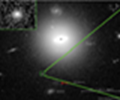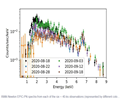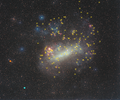Latest News - XMM-Newton
XMM-Newton Latest News
For older news stories regarding XMM-Newton please visit the News Archive
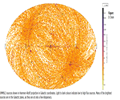
The third version of the XMM-Newton slew survey catalogue (XMMSL3) is now out
The third version of the XMM-Newton slew survey catalogue, XMMSL3, has been released on 19th February 2025 by the XMM-Newton Survey Science Centre (XMM-SSC) in collaboration with the SOC. This version includes an extra 8.5 years of data with respect to XMMSL3. There are 140735 X-ray detections which relate to 116598 unique sources, doubling the number of detections available in the previous version, XMMSL2. These detections come from 3120 pn slew observations that were taken by the 23rd August 2023. This catalogue version covers more than 90% of the sky, where some regions of the sky have been pointed as many as 78 times. Around 8% of all the detections are classified as extended. The median positional uncertainty of the catalogue detections is 13 arcseconds. Mean fluxes in the catalogue are ~2.8E-12 and ~6.5E-11 erg/cm²/s in the soft (0.2-2 keV) and hard (2-12 keV) X-ray band, respectively.
Details of the catalogue, the catalogue files and full XMMSL3 documentation are available on the XMM-SSC webpages at:
http://xmmssc.irap.omp.eu/Catalogue/XMMSL3/XMMSL3.html
FITS and CSV versions of the full XMMSL3 catalogue are also available for download at
http://www.cosmos.esa.int/web/xmm-newton/xsa
Alongside the XSA user interface, XMMSL3 is also distributed through:
The XMM-Newton XSA : http://nxsa.esac.esa.int/nxsa-web/#search
ESASky : https://sky.esa.int/esasky/
HEASARC Browse : http://heasarc.gsfc.nasa.gov/db-perl/W3Browse/w3browse.pl
Further details on our XMM-Newton SSC web portal.
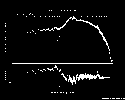
Version 22.0 of the Science Analysis System (SAS) released
The XMM-Newton SAS team is pleased to announce the release of a new version of the SAS : SAS v22.0.
Binaries for diverse flavours of Linux and Mac OS X are available at
https://www.cosmos.esa.int/web/xmm-newton/sas-download
The main improvements of this release can be found in the Release Notes:
https://www.cosmos.esa.int/web/xmm-newton/sas-release-notes-2200
This version of SAS is released in three 64-bit binary versions for Linux (Ubuntu 22.04LTS, Ubuntu 24.04LTS and Red HAT 8.10), and two for macOS (13.6.9, Ventura and 14.6.1, Sonoma). A version for Red HAT 9 is intended to be released shortly.
SAS analysis threads have been revised to ensure compatibility with the recently released SAS v22.0. They are available at
https://www.cosmos.esa.int/web/xmm-newton/sas-threads
Further details on our SAS web portal.

The SOC together with its partners at NASA from the XMM-Newton Guest Observer Facility will be hosting its first virtual Data Analysis Workshop April 1-3, 2025!
This workshop, geared towards new and experienced users of XMM-Newton data, will
(1) highlight the diverse scientific studies that can be enabled by XMM-Newton,
(2) introduce beginners to the Science Analysis Software (SAS) and Extended Source Analysis System (ESAS) as well as the XMM-Newton Science Archive (XSA), and
(3) introduce beginners and experienced users alike to SciServer and Datalabs.
The workshop will be split between presentations and hands-on sessions, distributed over more than 12h duration, to allow participants in Europe as well as the US to attend at convenient times. The goal of the workshop is to improve the accessibility and usability of XMM-Newton data and its data reduction and analysis software, and to introduce the tools created for use with SciServer and Datalabs, which focus on making data reduction more accessible regardless of computing resources and expertise available at a given institution. Registration is open HERE and free of charge. To prepare for the workshop, please register for an ESA Datalabs account and familiarise yourself with the interface: REGISTER HERE. Please use the invitation code “XMM2025” when registering with Datalabs, so your account can be assigned to the workshop.
Further details on the dedicated UMBC web portal.

Unlocking the secrets of the first Quasars: how they defy the laws of Physics to grow
The European Space Agency's XMM-Newton has detected rapidly fluctuating X-rays coming from the very edge of a supermassive black hole in the heart of a nearby galaxy. The results paint a fascinating picture that defies how we thought matter falls into such black holes, and points to a potential source of gravitational waves that ESA’s future mission, LISA, could see. XMM-Newton is showing us that black holes devour matter in more complex ways than astronomers first thought. Black holes are predictions of Albert Einstein’s theory of general relativity. They are gravitational monsters that imprison any piece of matter or energy that crosses their ‘surface’, a region of spacetime known as the event horizon.
Further details on ESA.int web portal and Science.nasa.gov web portal.
- Removed a total of (2) style text-align:center;
- Removed a total of (2) cellpadding attribute.








































 Sign in
Sign in
 Science & Technology
Science & Technology
